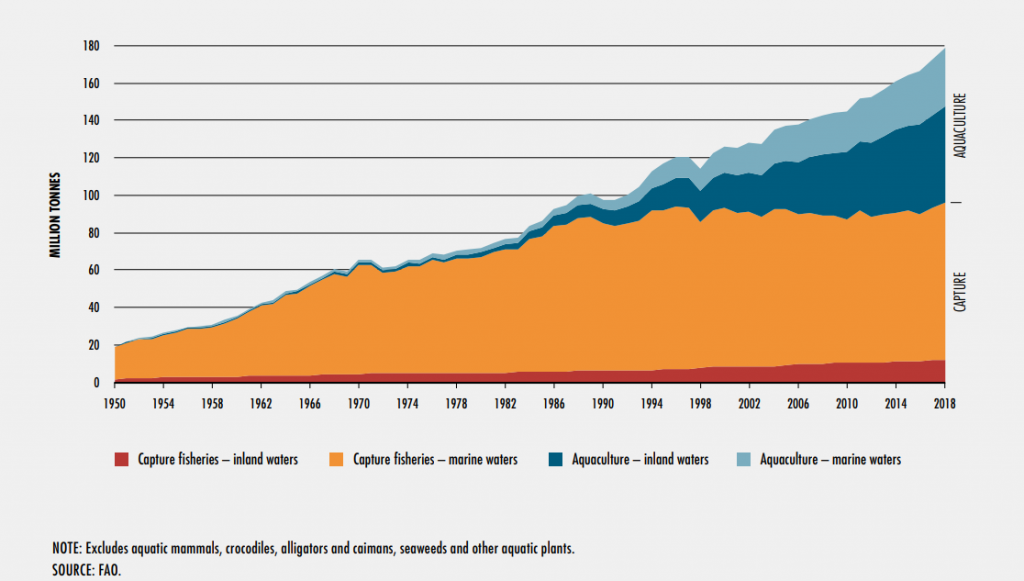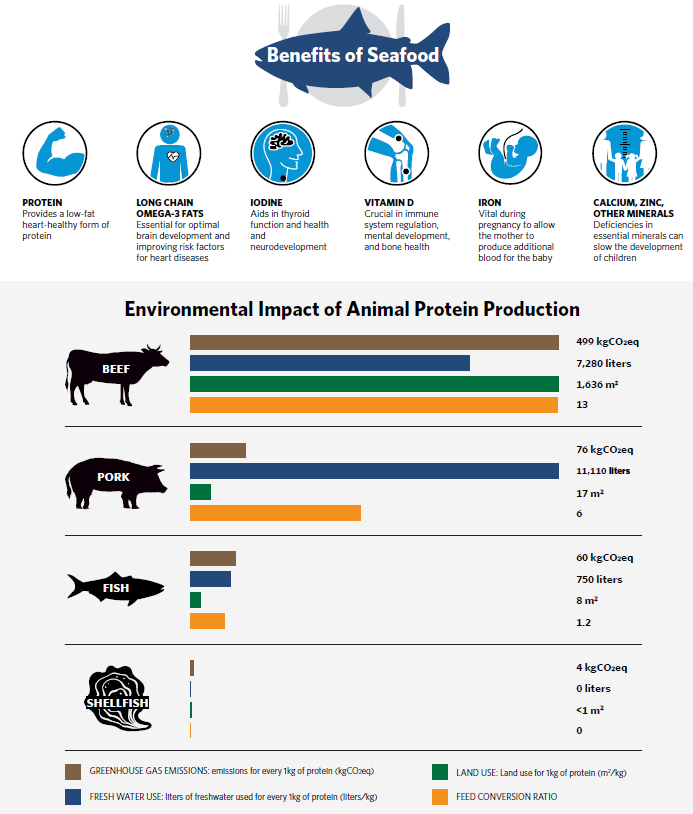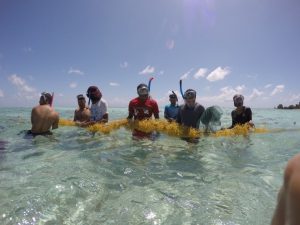Aquaculture Introduction
What is Aquaculture?
Aquaculture is the breeding, rearing, and harvesting of fish, shellfish, algae, and other organisms in all types of water environments. ref Aquaculture produces food and other commercial products, but similar techniques can be applied in non-commercial settings to restore habitats, replenish wild stocks, and rebuild populations of threatened and endangered species. Aquaculture can be separated into three main types – freshwater, marine, and brackish.
- Freshwater aquaculture occurs in rivers, lakes and ponds
- Marine aquaculture occurs in the open ocean, intercoastal areas, and marine lagoons
- Brackish aquaculture occurs in aquatic environments where the water is a mix of fresh and saltwater
While marine aquaculture can encompass a variety of organisms such as finfish, shellfish, crustaceans, aquatic plants, and microalgae, this module will focus primarily on the rearing of finfish and sea cucumber and the cultivation of seaweed in marine coastal environments.

World capture fisheries and aquaculture production. Source: FAO 2020
Why is it Important?
It is estimated that the world's population will be 9.7 billion by 2050. According to the Food and Agriculture Organization (FAO), that means that the world's food production will need to increase by 70% to meet the demand of the global population in that year. A growing body of research is showing that the world is running in an ecological deficit. It is estimated that 85% of the population lives in countries where the natural resources are being used at a rate faster than the environment can sustainably provide. Food production is a leading sector that is responsible for impacts to the environment, accounting for about 25% of global greenhouse gas emissions, 70% of freshwater use, and 80% of habitat loss. Meat like beef and pork, among other types of land-based animal proteins, have some of the highest rates of CO2 emissions, freshwater use, and land use per serving.
Wild fisheries and aquaculture can provide a source of high-quality, healthy animal protein that generally have a smaller land, carbon, and water use footprint than terrestrial animal agriculture. However, wild fisheries and aquaculture are not without impacts. Global wild fish stocks are in decline. In 2017, less than 70% of fish stocks were within biologically sustainable levels, a decrease of more than 20% since the 1970's, and since 1990, the global capture fisheries has increased by 14%. ref As the global demand for seafood continues to increase and the maximum sustainable yield from wild fisheries is reached, aquaculture will become a key supply of seafood for an increasing population. Aquaculture provides an alternative food system that can produce high-quality animal protein that, when done in the right ways, can have a sustainable footprint. Download the infographic below here.

Source: GHG, FW use, and LU data: Ritchie 2020; FW use for marine fish data: Pahlow et al. 2015; GHG for bivalves: MacLeod et al. 2020. FCR data: Sharpless and Evans 2013; Note: FW use data for marine fish was taken from Pahlow et al. 2015 as underlying data in Ritchie 2020 and was inclusive of freshwater aquaculture ponds. Freshwater usage varies by species and feed; Japanese Amberjack was used here.
Benefits of Aquaculture
Finfish and other types of aquaculture can have a lower environmental footprint than most meat production in terms of freshwater use, CO2 emissions, and land use. For example, swine production can use up to 6 kg of feed, 11,110 liters of water, and up to 17.4 m2 of land to produce 1 kg of protein. On the other hand, fish production can use up to 1.2 kg of feed, 750 liters of water, and up to 8.4 m2 of land to produce 1 kg of fish protein. Another important advantage is that the metabolic efficiency of fish is higher than terrestrial animals. A farmed salmon has a feed conversion ratio (FCR) close to 1, which means that it takes approximately 1 pound of feed to produce 1 pound of weight gain. By contrast, beef can have FCR of about 13. Feed conversion ratios are important because the more food (e.g., corn, soy, fish) needed to feed and grow an animal, the more land, water, and resources are used overall.


In-water seaweed farming training of fishing groups from across Belize. Photo © Julie Robinson
Aquaculture plays an important role in livelihoods, employment, and local economic development among coastal communities in many emerging countries. On a global scale in 2018, aquaculture employed 20.5 million people with 85% of those in Asia, where aquaculture is a prominent industry. In emerging countries, small-scale aquaculture is particularly relevant to safeguarding livelihoods because it may provide the principal source of income for local communities where alternative employment may be limited or lacking. ref Aquaculture activities, when properly managed for environmental risks and impacts, can offer a sustainable livelihood to coastal communities.
Farmers can also directly improve the health of aquatic environments while providing food for a growing population through practicing restorative aquaculture. Aquaculture of certain species, when farmed in the right way, can serve as a tool to help address water quality degradation, habitat loss, and climate pressures. For example, bivalve aquaculture can be sited to reduce excess anthropogenic nitrogen and phosphorous in the water and some types of aquaculture farms can form habitat that supports wild fish production. These outcomes could be enhanced if existing aquaculture industries implement restorative practices. Nearly all continents and most coastal countries have the potential for restorative aquaculture in marine environments when taking into account enabling environmental, socio-economic, and human health factors for development.

